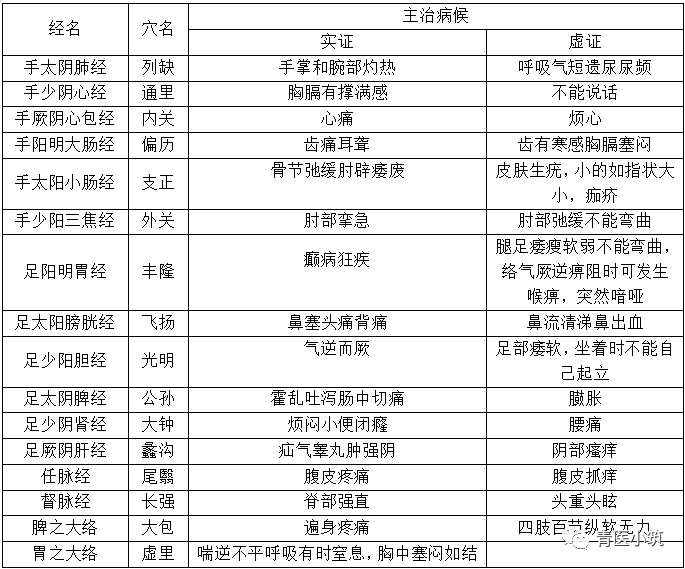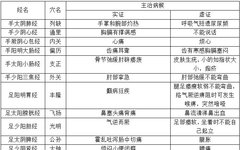Original Points and Luo Points
Original points (yuán xué) refer to the acupoints where the original qi of the organs passes through and resides in the twelve meridians. Each of the twelve meridians has an original point located near the wrist and ankle joints, known as the “twelve original points.”
Luo points (luò xué) refer to the acupoints where the luo vessels branch off from the meridians.
History
The concept of original points was first recorded in the “Lingshu: Nine Needles and Twelve Originals,” which documented the original points of the five zang organs (one for each side), along with the original points of the gallbladder and the heart, collectively referred to as the “twelve originals.” The “Lingshu: Ben Shu” further supplemented the original points of the six fu organs, and later, the “Nan Jing” added that “the original point of the Shaoyin is located at the Duokou (Shenmen),” thus completing the twelve original points. The original points of the yin meridians correspond to the shu points of the respective meridians, while the yang meridians have separate original points outside the shu points.
The content regarding luo points was first recorded in the “Lingshu: Meridians.”
Explanation of Original and Luo Points

1. Original Points
The twelve original points: “original” means source, referring to the original qi. The original qi originates from below the navel, between the kidneys, passes through the Sanjiao (Triple Burner), and spreads to the five zang and six fu organs, as well as the twelve meridians. Original points are the locations where the original qi of the organs passes through and resides. Each of the twelve meridians has an original point that best represents the state of the original qi of the corresponding organ, and acupuncture at these points can facilitate the flow of original qi in the Sanjiao, adjusting the functions of the internal organs. Therefore, the “Lingshu: Nine Needles and Twelve Originals” states regarding the therapeutic effects of original points: “All twelve originals treat diseases of the five zang and six fu organs.” This indicates their role in treating internal organ diseases. It also states: “If there is disease in the five zang, one should look to the twelve originals. Each original has its own indications, and by knowing its origin, one can understand the harm to the five zang.” Thus, according to the classical texts, it is clear that original points have diagnostic and therapeutic functions.

2. Luo Points
The term “luo” means network. In the meridians, the branches that run horizontally or laterally are called luo, serving as a connecting link. Each of the twelve meridians runs through the limbs below the elbows and knees, with each having a corresponding luo vessel, each with its own distribution route and associated symptoms. They connect the yin and yang meridians, moving from yin to yang and vice versa, and participate in the overall circulation of the twelve meridians, though they are not as deep or comprehensive as the main meridians. Therefore, the symptoms they reflect are mostly related to surface diseases of the limbs. The acupoints located on the luo vessels are called luo points. Luo points can communicate the relationship between the interior and exterior of the meridians, serving as pathways connecting the two, and they also act as the starting points for the luo vessels. Thus, they are also considered special acupoints. In addition to each of the twelve meridians having a luo point, the Ren (Conception) and Du (Governing) meridians, which run along the front and back of the body, also each have a luo point, and the Spleen meridian has an additional major luo. The Spleen governs the stomach and the distribution of fluids throughout the body, and its major luo connects the various luo vessels and the Ren and Du meridians, playing a linking role. Therefore, they are collectively referred to as the fifteen luo points. Another perspective suggests that the Stomach meridian also has a major luo, thus it can be referred to as sixteen luo points.

The clinical application of original and luo points is very extensive. Before that, it is recommended to familiarize oneself with the original and luo points, and it is suggested to memorize the following mnemonic:
Song of the Twelve Original Points
Taichong (Liver) and Qiuxu (Gallbladder),
Pericardium Daling and Stomach Chongyang,
Taiyuan (Lung) and Taixi (Kidney),
Jinggu (Bladder) is the original point,
Shenmen (Heart) and Taibai (Spleen),
Hegu (Large Intestine) at the wrist,
San Jiao should be taken from Yangchi,
Carefully detail the twelve original points.
Song of the Fifteen (Sixteen) Luo Points
Luo of the Lung is Lieque,
Stomach Fenglong, Spleen Gongsun,
Heart Tongli, Small Intestine,
Bladder Feiyang, Kidney Dazhong,
Pericardium Neiguan, Gallbladder Guangming,
Spleen’s major luo is Daba,
Yangdu (Du Meridian) Changqiang, Ren Wei Yi.
(Stomach’s major luo is Xuli)
Applications of Original and Luo Points
1. Applications of Original Points:
1. To treat internal organ diseases, one must use the original points of the corresponding meridian, which can be used alone or in combination with other points.
2. For diagnostic applications, if there is disease in the organs, one can find tender points at the original points or explore other variations, or use a meridian measuring device to assess skin conductivity to determine the condition of the organs.
3. The method of pairing points based on the connection between the organs and the exterior. This is similar to the pairing method of original and luo points, but it must be based on the day of the heavenly stem and the corresponding meridian to select the original and luo points, which will not be discussed here.
2. Applications of Luo Points:
1. Using luo points alone: One can select the luo point corresponding to the luo vessel based on the symptoms. For example, if there is coldness in the teeth or pain from cavities, it corresponds to the Hand Yangming Large Intestine meridian, and one can select the luo point of that meridian, Lieque, based on the condition of deficiency or excess.
2. Selecting points based on the course of the disease: According to the principle that “new diseases are in the meridians, chronic diseases are in the luo,” for newly developed diseases, one can use more meridian points, while for chronic diseases, one can appropriately combine luo points, as they are effective for chronic conditions.
3. Luo points can also be used for diagnosis, as they respond sensitively to diseases; for example, tenderness indicates an imbalance or obstruction of qi.
3. Applications of Pairing Original and Luo Points:
Luo points have a good effect on unblocking diseases of the interior and exterior. Whenever there is a surface disease affecting the interior or vice versa, they can be used. Specifically, whenever there is a disease in the main meridian or organ, involving the relationship between the interior and exterior, one should select the original point of the main meridian and the luo point of the corresponding exterior meridian.
For example, if the liver is diseased and involves the gallbladder, one should take the original point of the Liver meridian—Taichong as the main point, and then take the luo point of the Gallbladder meridian—Guangming as the secondary point; conversely, if the gallbladder is diseased and involves the liver, one should first take the original point of the Gallbladder meridian—Qiuxu as the main point, and then take the luo point of the Liver meridian—Ligu as the secondary point. This illustrates the principle of the liver being the master of the gallbladder and the gallbladder being the master of the liver in the pairing of original and luo points.
Attached Images
Table of Fifteen (Sixteen) Luo Points

Table of Original and Luo Points Pairing for the Twelve Meridians


